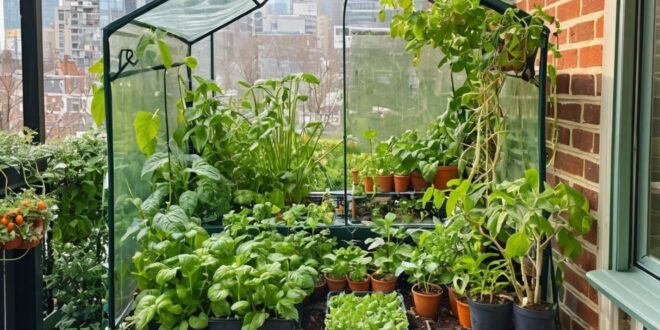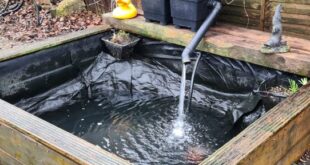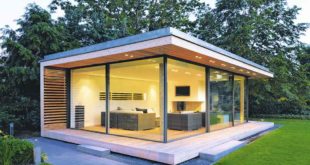Gardeners know the struggle of keeping plants alive during cold snaps and dry spells. They seek solutions to extend the growing season and create cosy spots for more delicate species.
Enter the mini greenhouse – a game-changer in cultivating plants outside their usual climate zone.
A mini greenhouse provides controlled environment for seeds to germinate, and tender plants to thrive. It’s like a tiny bubble where warmth, humidity control, and protection from frost come standard.
This article will guide you through types, materials, benefits, and even how to make your own.
Definition of a Mini Greenhouse
A mini greenhouse is a small structure that creates a controlled environment for plants. It uses less than 10 square feet of space. This small house keeps plants warm and lets them grow in cooler temperatures.
It can be made from various materials, including safety glass or plastic. People use these houses to start plant growth earlier in the season or to keep plants warm all year.
These greenhouses come in different shapes and sizes, fitting on tables or standing alone in gardens. They help create a microclimate with high humidity perfect for growing seeds and young plants.
With adjustable vents and sometimes even heating mats, they let gardeners control temperature and moisture levels easily. This makes sure plants like aubergines or flowers can start growing before the outdoor conditions are right.
Types of Mini Greenhouses
Mini greenhouses come in various shapes and sizes to meet different gardening needs. They create ideal environments for seeds to start, plants to grow, and flowers to bloom. Here are the main types:
- Cold Frames – Made of a wooden or metal box with a clear lid on top. They trap heat from the sun to keep plants warm, even during cold weather. Great for hardening off seedlings before moving them outside.
- Portable Greenhouses – These are small enough to move around. They often have a plastic cover over a frame made of metal or plastic pipes. This type lets gardeners change locations depending on the weather.
- Tiered Mini Greenhouses – These structures have several shelves stacked one atop another, providing space for more plants in a compact area. They’re perfect for small gardens or balconies.
- Lean-to Greenhouses – Attached to another building or wall, these utilise existing structures for support and easy access to electricity and water. Ideal for saving space while keeping your plants close by.
- Building Plastic Bottle Greenhouses: Creative gardeners use old plastic bottles assembled over frames to make eco-friendly mini greenhouses that cost almost nothing but time and effort.
- Pop-up Mini Greenhouses – Just like pop-up tents, these can be set up quickly when needed and put away easily. They’re great for gardeners who need flexibility without permanent structures.
- Heated Propagators – Not quite greenhouses but serve a similar purpose for germinating seeds or propagating cuttings with added warmth from built-in heating elements.
Each type offers unique benefits from protecting young plants from frosts, promoting faster growth with temperature control, conserving water by reducing evaporation, and preventing pests without chemicals pesticides making gardening more successful year-round.
Materials Used in Mini Greenhouses
Mini greenhouses play a crucial role in protecting plants. They use specific materials to create the perfect environment for growth. Here’s what you need to know:
- Metal pipes serve as strong frames, holding the structure together.
- Plastic pipe options offer a lightweight frame that’s easy to move.
- Wire frames provide a simple base for homemade mini greenhouses.
- Plastic bags act as covers, trapping heat and moisture inside.
- Toughened safety glass is chosen for its durability and clear visibility.
- Double-glazed windows help in insulation, keeping the internal temperature stable.
- Heat mats are used to warm the soil, boosting seed germination rates.
- Insulation materials keep the warmth in during cool temperate days.
- Climate control systems adjust temperatures to suit plant needs.
Each material plays a part in ensuring plants can grow well, no matter the outside weather conditions.
Common Uses of Mini Greenhouses
Mini greenhouses are perfect for starting seedlings early, a big help before the usual growing seasons. Gardeners love using them to get a head start. These small structures also let you clone plants and create special environments where they thrive.
For example, if you want to propagate plants that need lots of humidity, mini greenhouses are your go-to solution.
They’re not just for experts; even new gardeners can use them to grow kitchen gardens or exotic flowers that usually wouldn’t survive outdoors in their climate zone. This makes experimenting with different types of seeds easy and fun.
Whether it’s vegetables, fruits, or decorative plants, mini greenhouses offer protection from pests while controlling temperature and moisture – key factors for successful gardening year-round.
Benefits of Using a Mini Greenhouse
A mini greenhouse offers big perks for gardeners. It lets you start growing plants earlier in the year. You can keep growing them later, too. This means your flowers, veggies, and fruits get more time to grow.
Inside a mini greenhouse, you create special spots that are just right for different kinds of plants. Whether they love lots of heat or prefer it cooler, you can set things up perfectly.
Using a mini greenhouse also saves water – a win for both your water bill and the planet. It’s great for keeping pests away without needing to use harsh chemicals. So, your plants stay healthy and safe naturally.
Plus, if you’re into exotic plants like orchids or cacti, a mini greenhouse gives them the humid home they need to thrive all year round.
Key Features to Look for in a Mini Greenhouse
Choosing the right mini greenhouse is crucial for your gardening success. Look for features that match your needs and space.
- Size under 10 square feet to ensure it fits in limited spaces.
- Durable materials like metal or plastic pipes for long-lasting use.
- Multiple shelves, ranging from one to three, maximise plant growing area.
- Easy temperature and humidity control to cater to different plant needs.
- Transparent covers for maximum sunlight exposure.
- Ventilation options to prevent overheating and allow air circulation.
- Waterproof and UV-resistant covering to protect plants year-round.
- Easy assembly and disassembly for seasonal storage or relocation.
- Adjustable shelf heights to accommodate plants of various sizes.
- Portability features like wheels or lightweight design for moving with ease.
Ensure the mini greenhouse you choose has these key features for an optimal growing environment.
Size and Space Requirements
Mini greenhouses need small spaces. They use less than 10 square feet of ground or floor area. This makes them perfect for gardens where space is tight. Gardeners in compact areas can still grow plants like they would in a larger garden.
These structures fit well on balconies, patios, or small yards. Ideal for transplanting young plants that need protection, mini greenhouses offer a solution without taking up too much room.
Temperature and Humidity Control
Monitoring temperature and humidity in the mini greenhouse is crucial to prevent issues like fungal diseases and root rot. It’s important to maintain the right balance – for most plants, a temperature of 65-75°F during the day and slightly cooler at night works well.
Humidity levels should be around 50-70%, but this can vary depending on the type of plants inside. Consider using a thermometer and a hygrometer to accurately measure these conditions.
Ensuring proper ventilation also helps regulate temperature and humidity levels in the mini greenhouse. This could involve opening vents or windows during warmer periods, while installing fans can help circulate air, preventing moisture buildup that might lead to mold or mildew.
Additionally, shading systems or applying light-colored shade cloths can help lower temperatures during hot spells, maintaining an optimal environment for plant growth.
Always consider your specific location’s climate when regulating temperature and humidity. For example, if you’re in a drier region, you may need to water more frequently to maintain adequate humidity levels within the mini greenhouse.
Regularly checking and adjusting these factors will contribute significantly towards healthy plant growth in your mini greenhouse setup.
How to Buy a Mini Greenhouse
When buying a mini greenhouse, consider these factors:
- Determine the size based on available space and the number of plants you want to grow.
- Choose the material based on durability, insulation, and transparency requirements.
- Check for features like ventilation, shelving, and UV protection to suit your needs.
- Compare prices from different mini greenhouse suppliers or decide if building a DIY option is more suitable. A webshop like Halls could be a starting point if you’re looking for a mini greenhouse.
- Ensure temperature and humidity controls are adequate for your local climate.
- Look for additional accessories such as heaters, fans, or automatic watering systems if needed.
- Consider the warranty and after-sales service offered by the supplier.
- Read customer reviews to gauge product quality and performance before making a purchase decision.
DIY Mini Greenhouse Ideas
Looking to create your own mini greenhouse? Check out simple designs and basic materials for making DIY greenhouses.
Basic materials for homemade greenhouses
Homemade greenhouses can be crafted from simple materials like wire frames and plastic bags. These basic components help to create a sealed environment conducive for plant growth. Wire frames provide structural support, while plastic bags assist in sealing the greenhouse and maintaining adequate humidity levels.
This affordable approach allows gardeners and greenhouse owners to establish their own mini greenhouses without investing in expensive materials or equipment.
Simple designs for DIY mini greenhouses
One simple design for a DIY mini greenhouse is to use a wire frame inside a turkey bag to create an effective structure. This makeshift method is inexpensive and can provide protection for small plants in your garden.
Another basic design involves using clear plastic or PVC pipes to make a small, transparent shelter that lets sunlight in while keeping the cold out.
Moreover, constructing a mini greenhouse with wooden frames and plastic sheeting is another easy way for gardeners to protect their plants from harsh weather conditions during the colder months.
These designs are straightforward and cost-effective options for anyone looking to build their own mini greenhouse at home without much hassle.
Maintenance Tips for Mini Greenhouses
Maintaining a mini greenhouse involves monitoring temperature and humidity to create the ideal growing environment. It also includes preventing fungal diseases and root rot by ensuring proper ventilation and drainage within the greenhouse.
Monitoring temperature and humidity
To maintain a healthy environment, it’s crucial to monitor the temperature and humidity inside your mini greenhouse. Proper monitoring helps prevent issues like fungal diseases and root rot, which can harm your plants.
Use a reliable thermometer and hygrometer to keep track of the temperature and humidity levels consistently. This will help you make adjustments as needed to create an optimal growing environment for your plants.
By keeping a close eye on temperature and humidity, you can ensure that your plants thrive in the best possible conditions. Regular monitoring empowers you to take proactive steps to maintain an ideal growing environment within your mini greenhouse.
Preventing fungal diseases and root rot
Proper humidity control and vigilant monitoring can prevent fungal diseases and root rot. Ensure good air circulation by leaving space between plants, using a fan or opening vents.
Water the soil directly, rather than overhead, to reduce excess moisture. Employ organic mulch to moderate temperature and retain moisture. Use well-draining soil mixtures, rotate crops regularly, and prune infected parts promptly.
Regularly inspect plants for signs of disease or pests; early detection helps prevent their spread. Additionally, sanitise tools after each use to avoid spreading infections from one plant to another.
Remember that maintaining a clean environment is crucial in preventing fungal diseases and root rot in your mini greenhouse.
 Gardeners Club The Gardeners Club is a free to join online club for everyone with an interest in gardening and gardens.
Gardeners Club The Gardeners Club is a free to join online club for everyone with an interest in gardening and gardens.






